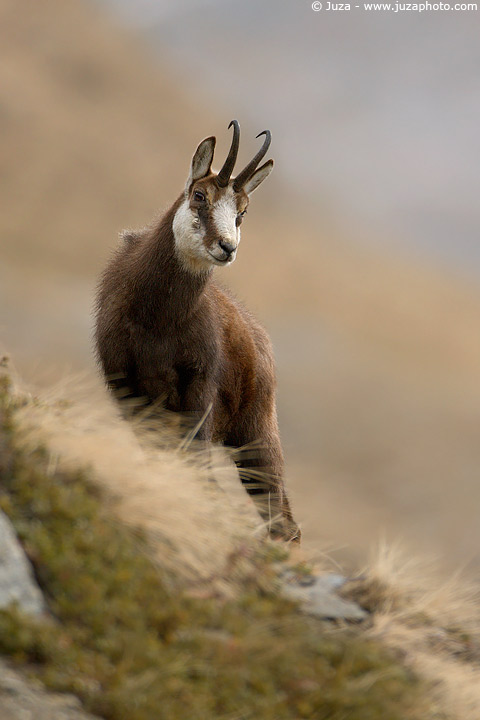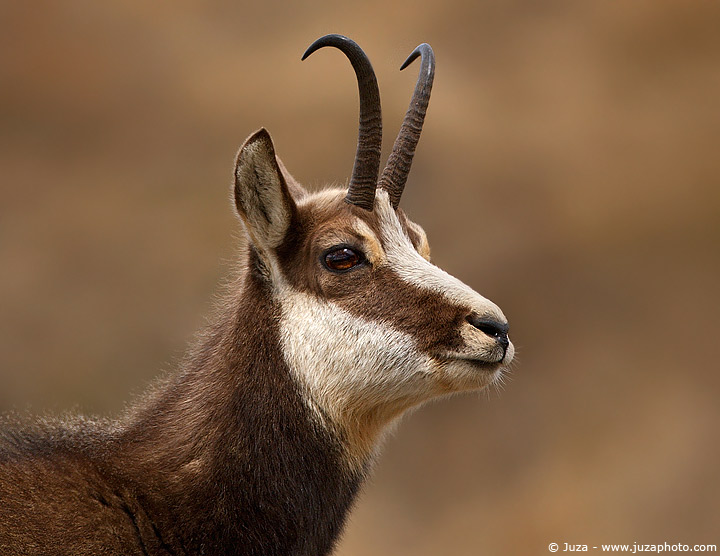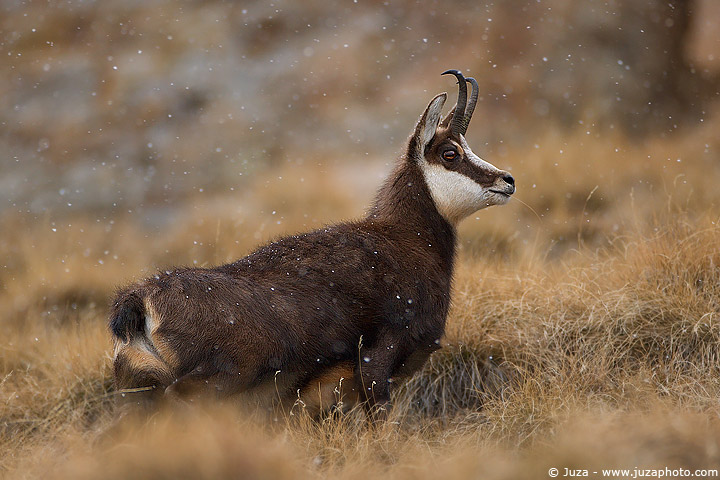Chamoises
Chamoises, testo e foto by
Juza. Pubblicato il 08 Giugno 2012; 0 risposte, 4723 visite.

Canon EOS 20D, Canon EF 600mm f/4 L IS USM, 1/2000 f/4, iso 400, handheld. Gran Paradiso, Italy.
The Canon 600 f/4 L IS USM usually is considered a "tripod lens" - it weights 5.5 kg, and it is not easy to handheld it for an entire day. But I knew that we were going to walk a lot, and I wanted to reduce weight as much as possible, so I decided to leave at home the sturdy, but bulky and heavy, Gitzo 1548 tripod with Wimberley head. I carried with me only the 600 f/4, the 1.4x TC (that I never used in this trip - the animals were much closer than I expected!), the 20D body and few spare CF cards. As usual when I walk for hours with the 600 f/4, I carried it using the lens foot as an handle. I highly recomment to don't swap the comfortable lens foot of Canon superteles with low-profile foots - they improves slightly the stability when the lens is mounted on the tripod, but they make impossible to use the foot as handle. With the current Nikon superteles, instead, a replacement low-profile foot is a good choice, since the standard foot is exaggerately high.
We (myself and my friends Apomaio and Max) begun the walk few kilometers after the small village of Ceresole (Piedmont), following a quite easy trail, that somewhere was covered by snow and ice. After 20 minutes, we saw the first chamois...I quickly grabbed the lens and I toke some test shot. The sky was cloudy, but pretty bright: in these situations, the light is excellent, since it is quite soft and diffused and there are not harsh shadows, but there is enough brightness to get fast shutter speeds. I set the ISO on 400 and, of course, the aperture on f/4 (wide open). With large animals as the chamoises, at f/4 the depth of field is more than enough - actually, even f/2.8 of f/2.0 would be enough if the subject is parallel to the camera.
The 600 f/4 is a killer lens for large mammals...I was able to photograph from 60/70 meters from the subject and to get frame-filling photos! And the very long focal, together with the wide aperture, gives a beautifully clean, out of focus background. These chamoises were relatively tame and I was able to get as close as 15/20 meters, for some portrait shots.

Canon EOS 20D, Canon EF 600mm f/4 L IS USM, 1/1250 f/4, iso 400, handheld. Gran Paradiso, Italy.
I set the image stabilizator on mode 1 - more effective than mode 2 - and I tried to keep the lens as steedy as possible when I toke the photos. To get a faster and more reliable autofocus, I set the focus limiter on 16.2mt-infinity (the 600 f/4 has a focus limiter switch with three settings: 5.5meters-infinity, 16.2mt-infinity, 5.5mt-16.2mt) and I selected the center AF area. When the subject was moving, I tried to place the AF area on the head and I left some empty room all around to crop the photo to an off-center composition during post-processing. When the chamoises stayied still, instead, I focussed on the head, I locked the focus and I recomposed the photo. I always use continuous AF (AI Servo), since I want to be always ready to follow the action, so it is necessary to use the * button when I want to focus and recompose. By default, the function of the * button is "Exposure Lock", not AF Lock; to use it as AF lock, set the custom function "4: Shutter button / AE lock button" on "2: AF/AF lock, no AE lock" (the shutter button activates AF; the star button stops AF, the exposure lock is not available).
In the afternoon, the sky became more cloudy, and after some time we were in the middle of a snowstorm, at an altitude of nearly 2000 meters. The trail was easy and we were well equipped, so we weren't worryed at all - actually, I was pretty happy, since the falling snow is a great plus - it really adds a magic winter mood to the photos!
Unlucky, the chamoises had moved away from use and the closest herd was 100 meters higher than us. Aften one day spent walking and handholding the 600 f/4 I was a bit tired, but I couldn't have missed that fantastic opportunity to photograph the chamoises in snowstorm, so I left the trail and I begun to go up on the steep mountainside. In some areas there was a lot of snow so I was not able to evaluate the stability of the ground - and I didn't notices a deep hole, until I suddenly sinked in the snow up to waist! I almost dropped the big lens on the ground but the large lens hood protected the front element. I always use the lens hood (except when I am in tight spaces as the hides), even in cloudy days and in shadow...even when there is no risk of flare, it is very useful to protect the front element. (instead, I never use protective filters, in my opinion they are useless, and they might just reduce image quality.)

Canon EOS 20D, Canon EF 600mm f/4 L IS USM, 1/640 f/4, iso 400, handheld. Gran Paradiso, Italy.
With a considerable effort, I managed to get at nearly 50 meters from the chamoises. I was really tired and I was not able to handhold steadily the big lens; moreover, the light was getting more dim, and the shutter speed had dropped to 1/640 at ISO 400. I was in a very precarious equilibrium, leaned against the side of the mountain, but I tried to stay as steady as I can, resting my left elbow on the ground. In less than twenty minutes, I toke almost one hundreds shots: when I have a good subject, I try to take as many photos has possible, to have more oddies of getting at least few good shots. This photo of the chamois in snowstorm is one of my favourites - the falling snow is clearly visible, and the razor sharp subject stands out from the nice background. The body of the chamois is turned slightly away from the camera, but I waited until it turned the head towards me. The post processing had been relatively easy - I warmed up a little the colors (the photos taken in cloudy days have always a more or less pronunced blue cast), I increased the contrast, paying attention to don't clip the highlights, and I applied some noise reduction in the out of focus areas.
Risposte e commenti
Che cosa ne pensi di questo articolo?
Vuoi dire la tua, fare domande all'autore o semplicemente fare i complimenti per un articolo che ti ha colpito particolarmente? Per partecipare iscriviti a JuzaPhoto, è semplice e gratuito!
Non solo: iscrivendoti potrai creare una tua pagina personale, pubblicare foto, ricevere commenti, partecipare alle discussioni e sfruttare tutte le funzionalità di JuzaPhoto. Con oltre 256000 iscritti, c'è spazio per tutti, dal principiante al professionista.




 JuzaPhoto contiene link affiliati Amazon ed Ebay e riceve una commissione in caso di acquisto attraverso link affiliati.
JuzaPhoto contiene link affiliati Amazon ed Ebay e riceve una commissione in caso di acquisto attraverso link affiliati.